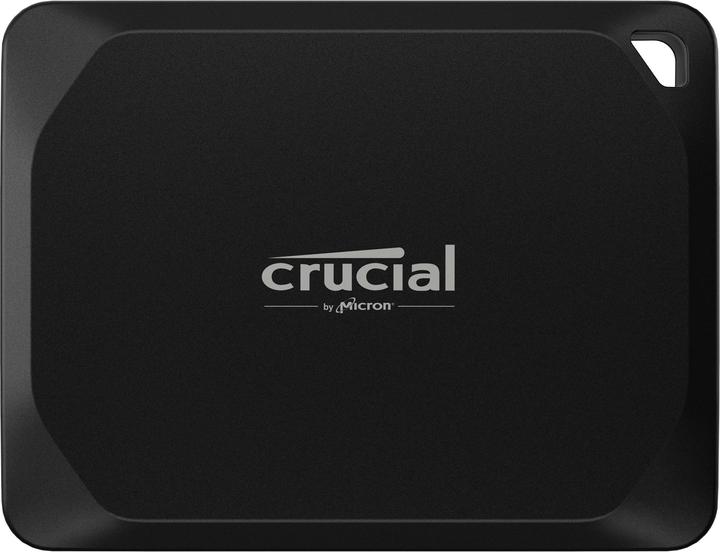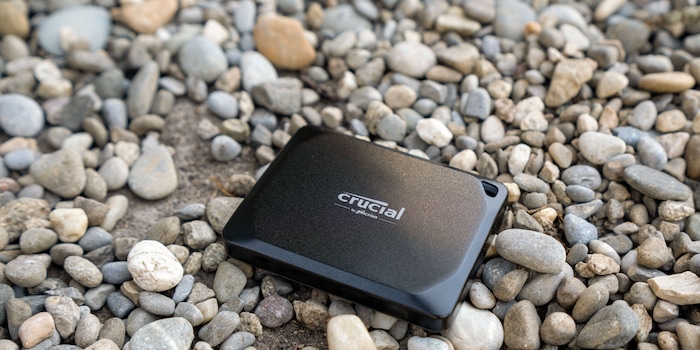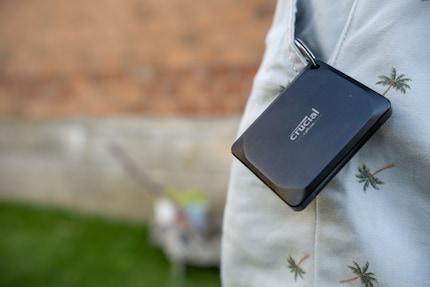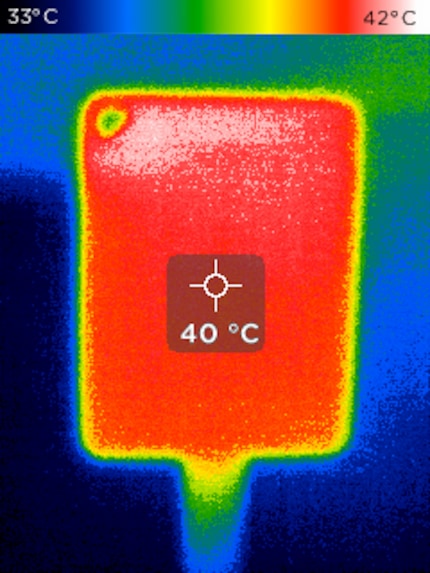

Crucial X10 Pro – not for the masses
The Crucial X10 Pro features USB 3.2 Gen2x2. Thanks to this fast connection standard, the external SSD raced through my tests. However, these speeds are reserved for a select a few.
If you work with photos and videos, the Crucial X10 Pro might be for you. It allows you to transfer data packages of around 100 GB in under 100 seconds. However, to benefit from the high speed, you need the right USB port. Namely, USB 3.2 Gen2x2.

The Crucial X10 Pro breakdown
The X10 Pro’s available with 1, 2 and 4 terabyte of storage. At 65 × 50 × 10 millimetres, it’s more compact than the Samsung T7 or SanDisk Extreme PRO Portable. The SSD weighs a mere 42 grammes. Thanks to an eyelet, you can attach it to your keychain.
It’s sturdy, too, with a black aluminium housing that provides IP55-standard protection against dust and water. The SSD is connected via USB-C on both sides. The USB-A needs to be bought separately.

Source: Kevin Hofer
The SM2320 from Silicon Motion is used as the controller. It’s a single-chip controller. This eliminates the need for a bridge chip to translate from the SATA/NVMe to the USB protocol. This makes external SSDs lighter and more compact.
Crucial uses 176-layer TLC for the 3D NAND memory. NAND is a non-volatile memory technology that doesn’t require power to store data. TLC stands for Triple Level Cell. This means 3 Bits are allocated per memory cell. Furthermore, the SSD also offers 256-bit AES encryption and a five-year manufacturer warranty.
Crucial seems to have stepped on the gas when it comes to data transfer. According to the manufacturer, the transfer rates are 2,100 megabytes per second (MB/s) for reading and 2,000 MB/s for writing. Please note: to reach these speeds, it’s crucial that your notebook or PC’s equipped with a USB 3.2 Gen2x2 port. Although Thunderbolt 3 or 4 are faster on paper, transfer rates of only up to 1,000 MB/s are possible with them. This is because USB 3.2 Gen2x2 transmits via two lanes and Thunderbolt 3 and 4 only via one.
Sequential write and read speed in the ATTO Disk Benchmark
Sequentially stored data is saved in contiguous blocks. Thanks to sequential read and write, you can estimate how fast the SSD is when accessing large multimedia files, transcoding videos or watching movies. Manufacturers like to quote sequential speeds, as they offer the highest values.
I perform all tests on my test system, which has the following components:
The following chart shows the results in comparison with external SSDs I already tested. One of them also with the USB 3.2 Gen2x2 standard, and two of them with the USB 3.2 Gen2 standard. To keep things clear and understandable, I didn’t add each individual result to the graph. You can see the maximum measured results.
With 1,970 MB/s, the X10 Pro doesn’t reach the specified maximum read speed of 2,100 MB/s. Most internal as well as external SSDs fail to reach the official rates in the benchmark. This is because these are theoretical rates that are only reached under optimal conditions. Measured against the other SSDs, the difference between promised and actual performance is about the same. Reaching 1,730 MB/s, it’s even further off the mark with the stated write speed of 2,000 MB/s. The external SSD only deploys its full read and write speed from a file size of about 512 kilobytes (KB).
Compared to the tested SSDs with USB 3.2 Gen2 standard – the SanDisk Extreme V2 and the Samsung T7 Touch – the read and write speeds are doubled. It’s behind the USB 3.2 Gen2x2 competitor SanDisk Extreme Pro V2 for write.
Random access and more on sequential speed
While the MB/s value is key for sequential read and write, the IOPS values are central for random write. The higher the IOPS values, the faster the SSD. The shorter the response times, the faster the SSD reacts. Random read and writes refer to data that isn’t stored in contiguous memory cells; they’re randomly distributed on the SSD.
While the X10 Pro was still behind the SanDisk Extreme Pro V2 in sequential writing, it storms past its USB 3.2 Gen2x2 competitor in random reading and writing. All in all, 7.5 per cent more points could be achieved.
Transferring files
To test the SSD’s performance in real-world scenarios, I copy various files from the system drive to the X10 Pro.
First up is a 101-GB folder with MP4, RAW photos and a Premiere Pro project. The X10 Pro takes 97 seconds for this. The speed is 1,030 MB/s on average. The SSD can keep this up for the entire transfer time. This makes the X10 Pro one second faster than the Extreme Pro V2. The competition with a slower transmission standard is beaten by more than a minute.
When the external drive isn’t in use, the Crystal Disk Info software shows me 26 degrees Celsius. During the transfer of the 101 GB folder, the temperature rises to 36 degrees Celsius. On the outside, the external SSD gets even hotter, as you can see on the thermal image. Nonetheless, this value is very good and far below the maximum that an SSD can put up with.

Source: Kevin Hofer
In my second test, I copy a folder of almost 10 GB containing MTS, MP4, MP3, MOV and JPEG files as well as another Premiere project. This time, the X10 Pro is as fast as the Extreme Pro V2. The transfer speed isn’t as fast as in the first test and does 950 MB/s on average. This is probably because the folder contains a higher number of files, which means that the random accesses rather than the sequential ones come into play.
The same is even truer for the last test. The almost 4 GB folder contains more than 160 photos in RAW format. Here, the two external SSDs with the same connection standard are again equally fast at around 910 MB/s.
The X10 Pro only throttles down during data transfer from a fill level of about 90 per cent. Then the write speed is only 200 MB/s on average. If I move files around on the SSD itself, the speed is significantly lower than during data transfer. I measure around 300 MB/s on average.
Conclusion: crazy fast SSD if you have the right connection standard
The Crucial X10 Pro is the fastest SSD with USB 3.2 Gen2x2 standard I’ve tested. It makes good use of the bandwidth of 2,000 MB/s that’s potentially possible. If you’re trying to dodge the significantly higher cost of a Thunderbolt 3-capable external SSD, the X10 Pro is the next fastest thing.
The only question is: does your computer or notebook support USB 3.2 Gen2x2? Many devices don’t, even though they have Thunderbolt 3 or even 4. With these standards, even more bandwidth is theoretically available. However, the X10 Pro can only use 1,000 MB/s of this due to the different standard. So before buying, make sure your PC or notebook is also USB 3.2 Gen2x2 capable.
If you need read and write speeds beyond 1,700 MB/s and have the appropriate end device, I can recommend the X10 Pro. If you need even more speed, you should go for a Thunderbolt 3-capable external SSD. But if you’re not in that much of a rush when transferring data, you might be better saving money by going with a USB 3.2 Gen2 SSD. For example, with Crucial’s X9 Pro, which I’ll take a closer look at soon.
From big data to big brother, Cyborgs to Sci-Fi. All aspects of technology and society fascinate me.







